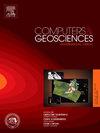SeisSegDiff:用于地震相分类的有效标记的少弹纹理分割扩散模型
IF 4.2
2区 地球科学
Q1 COMPUTER SCIENCE, INTERDISCIPLINARY APPLICATIONS
引用次数: 0
摘要
传统的地震相分析依赖于人工解释地震振幅,由于地震数据的复杂性、体积和有限的分辨率而遇到困难。为了解决这些问题,基于地震纹理的深度学习已经成为一种非常有前途的技术。然而,对大量标记数据集的依赖构成了一个重大障碍。本文介绍了一种结合扩散概率模型和深度学习模型的地震纹理分类创新方法SeisSegDiff。利用扩散模型提高了地震相分割深度学习模型的泛化能力和精度。该方法利用从Unet去噪网络的中间层获得的特征映射来估计反向扩散过程的马尔可夫相位,作为地震图像的表示。这些特征图作为解决深度学习地震解释挑战的高级语义信息,从而减少了对大型标记数据集的需求。我们通过在荷兰F3和Parihaka盆地的两个地震基准数据集上进行实验来评估SeisSegDiff的有效性。结果表明,该方法在确定地下相边界和构造方面具有优异的性能。SeisSegDiff使用最小标记数据集(约1%内联)的能力进一步强调了其在实际现场部署中的潜力。我们的工作将使地球物理深度学习社区更接近为自动地震解释和成本有效的地下表征创建统一的全球地震纹理模型的目标。本文章由计算机程序翻译,如有差异,请以英文原文为准。
SeisSegDiff: A label-efficient few-shot texture segmentation diffusion model for seismic facies classification
Traditional seismic facies analysis, which depends on manual interpretation of seimic amplitude, encounters difficulties because of the complexity, volume, and limited resolution of the seismic data. To tackle these problems, seismic texture based deep learning has emerged as a highly promising technique. However, the reliance on extensive labeled datasets poses a significant hurdle. Here we introduce SeisSegDiff, an innovative approach to seismic texture classification that combines diffusion probabilistic models with deep learning models. We use diffusion models to enhance the generalization capabilities and accuracy of deep learning models for seismic facies segmentation. The proposed method utilizes the feature maps obtained from the intermediate layers of a Unet denoising network that estimates the Markov phase of the reverse diffusion process, serving as seismic image representations. These feature maps serve as high-level semantic information for addressing deep learning seismic interpretation challenges, hence reducing the requirement for large, labeled datasets. We assess the effectiveness of SeisSegDiff by conducting experiments on two seismic benchmark datasets from the Netherlands F3 and the Parihaka Basin. The results demonstrate the exceptional performance of our method in defining subsurface facies boundaries and structures. The ability of SeisSegDiff to operate with minimal labeled datasets (∼<1% inlines) further emphasizes its potential for practical field deployments. Our work will draw the geophysical deep learning community closer to the goal of creating a unified global seismic texture model for automatic seismic interpretation and cost effective subsurafe characterization.
求助全文
通过发布文献求助,成功后即可免费获取论文全文。
去求助
来源期刊

Computers & Geosciences
地学-地球科学综合
CiteScore
9.30
自引率
6.80%
发文量
164
审稿时长
3.4 months
期刊介绍:
Computers & Geosciences publishes high impact, original research at the interface between Computer Sciences and Geosciences. Publications should apply modern computer science paradigms, whether computational or informatics-based, to address problems in the geosciences.
 求助内容:
求助内容: 应助结果提醒方式:
应助结果提醒方式:


